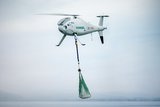Sonardyne Ranger USBL tracks Jason ROV at 5000 metres
A Ranger Wideband USBL (Ultra-Short BaseLine) acoustic positioning system from Sonardyne International Ltd has provided impressive performance for the engineers from the Deep Submergence Laboratory of Woods Hole Oceanographic Institution (WHOI) when it accurately tracked the Jason remotely operated vehicle down to the seabed in 4,700 metres of water. The recent demonstration was carried out from onboard the R/V Thomas G Thompson in the Pacific Ocean off Hawaii where Woods Hole researchers regularly conduct deep ocean research cruises.
Jason is a two-body ROV system designed and built by WHOI's Deep Submergence Laboratory. A 10 kilometre (6 mile) fibre-optic umbilical delivers electrical power and commands from the ship through Medea and down to Jason, which then returns data and live video imagery. Medea serves as a shock absorber, buffering Jason from the movements of the ship, while providing lighting and a bird's eye view of the ROV during seafloor operations.
On route to the trials site, a Sonardyne engineer had equipped Jason with an AvTrak 2 transceiver and Medea, with a directional Compatt 5 transponder. AvTrak 2 combines the functions of transponder, transceiver and telemetry link in one low power acoustic instrument that has been designed to meet the requirements of a variety of mission scenarios and vehicle types. Onboard the Thomas G Thompson, a Sonardyne 8023 Big Head surface transceiver, specifically developed for ultra deep target tracking, was deployed on a temporary pole over-the-side of the vessel.
During the deepwater dive to almost 5,000 metres, the Sonardyne system was able to achieve a positioning accuracy of 0.32% of slant range, or +/-15 metres, despite the temporary, relatively flexible, over-the-side pole. This performance proved almost as good as WHOI's existing tracking system and far more convenient to use as no seabed transponders have to be deployed first. In addition, Jason's position could be updated at 1Hz despite the water depth which helped with visualisation of the ROV's dynamics.
AvTrak2 was installed on the ROV to demonstrate the unit's Wideband positioning and bi-directional wireless communications capability as if it were an AUV or manned submersible. This proved that data and commands could be reliably and easily sent from the USBL system on the vessel and back again using SMS (Sonardyne Messaging Service) in ultra deepwater.
Because the Ranger USBL system had shown its capabilities so convincingly, the WHOI team subsequently had the confidence to use it as the primary positioning tool for two further research dives to 2,500 metres that they conducted shortly afterwards.
More from Uncrewed Vehicles
-
Jammer resistant drone designs spark search for countermeasures
The Russia-Ukraine conflict has driven another stage of evolution for drones and the counter measures to defend against them.
-
![L3Harris launches Amorphous software for control of uncrewed platforms]()
L3Harris launches Amorphous software for control of uncrewed platforms
The new Amorphous software is a universal controller that would allow a single operator to control a swarm of “thousands” of uncrewed systems, from drones to underwater platforms.
-
ideaForge unveils new UAVs at Aero India 2025
India UAV supplier ideaForge has launched the Netra 5 and Switch V2 drones at Aero India 2025, boasting of enhanced endurance, AI-driven autonomy and improved operational capabilities.
-
![Shaping the future of defence: What 2025 holds for the global drone market]()
Shaping the future of defence: What 2025 holds for the global drone market
The UAV market is experiencing unprecedented growth, with innovations in technology and battlefield applications driving demand across military sectors. From the battlefields of Ukraine to NATO exercises and beyond, drones are transforming how wars are fought and supported.
-
![Maris-Tech confirms customers signing up for Jupiter Drones codec and AI-powered system]()
Maris-Tech confirms customers signing up for Jupiter Drones codec and AI-powered system
Launched at AUSA in October, the company’s multi-stream video codec is attempting to bring a new lease of life to drone technology through its AI accelerator.
-
![AUSA 2024: Quantum-Systems targets big 2025 with UAS developments]()
AUSA 2024: Quantum-Systems targets big 2025 with UAS developments
Quantum-Systems has been upgrading its UAS family, with new versions of the Vector, Reliant and Twister drones set for release throughout 2025.
























